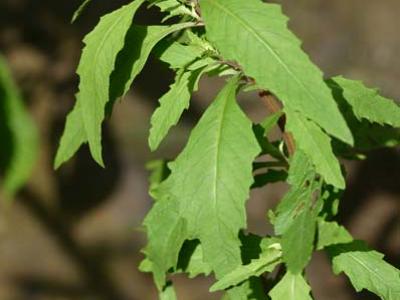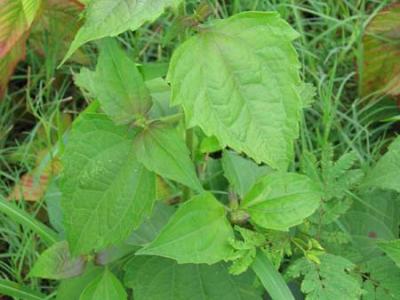(In territories with significant traditional TRAMIL use)
Mexico:
- apazote
- epazote
Guatemala:
- apazote
- epazote
Honduras:
- apazote
- epazote
Dominican Republic:
- apazote, epazote
Haiti:
- feuilles à vers
- simen-kontra
Martinique:
- herbe à vers
- simen-kontra
- zèb avè
Colombia:
- paico
- yerba santa
Panama:
- paico
Venezuela:
- pazote
Guadeloupe:
- simen-kontra
Trinidad and Tobago:
- worm grass
Dominica:
- wormweed
aerial parts, pressed, local application4
According to the information available:
The use for diarrhoea and stomach pain (only for those caused by the following intestinal parasites: ascaris, pinworms and hookworms) is classified as REC based on the significant traditional use documented in the TRAMIL surveys, the toxicity studies and the scientific information published.
Under no circumstances should the specified preparation and dosage form be altered.
The use of this resource in cases of diarrhoea should be considered complementary to oral rehydration therapy.
If the diarrhoea persists for more than 2 days or if deterioration is observed in the patient (dehydration with dry tongue, decreased skin turgor, oliguria or crying without tears), seek immediate medical attention.
If deterioration is observed in the patient or if the stomach pain persists for more than 3 days in adults or 2 days in children over 5 years of age, seek medical attention.
Oral use is contraindicated in individuals with liver disease, kidney failure18, weak or elderly patients.
The use for skin ulcers is classified as REC based on the significant traditional use documented in the TRAMIL surveys, the dermal toxicity trials and the scientific information available and the dermal irritability trials.
If deterioration is observed in the patient or the skin ulcer persists for more than 5 days, seek medical attention.
All topical application must follow strict hygiene measures in order to prevent contamination or additional infection.
Not for use during pregnancy because it can cause miscarriage, nor while breastfeeding or in children under 5 years of age.
For diarrhoea or stomach pain caused by intestinal parasites (ascaris), pinworms or hookworms:
prepare a decoction or infusion with 7 grams of aerial parts (leaves, flowers and stems) in 1 cup (250 millilitres) of water. For decoctions, boil for 5 minutes in a covered vessel; for the infusion add the boiling water to the 7 grams of aerial parts, cover and leave to cool for 10 minutes. For both preparations strain (filter) and drink 1 cup (250 millilitres) for adults, ½ cup (125 millilitres) for people weighing 35 kg, and 1/3 cup (80 millilitres) for children over 5 years old. Drink once a day only for 3 days in a row53 and do not repeat this treatment until 6 months have passed.
It is recommended to take a saline laxative (e.g. magnesium sulfate) after the last dose, but oily laxatives should not be used18.
For skin ulcers:
wash the wound with boiled water and soap. Adequately wash the aerial parts of the plant, press or crush them and apply to the affected area. Cover with a clean cloth and change twice a day.
Preparations must never be stored for more than 24 hours, even if refrigerated.
1 GIRÓN L, 1988
Encuesta TRAMIL (Costa atlántica). Centro Mesoamericano de Tecnología CEMAT, Guatemala, Guatemala.
2 DELENS M, 1990-92
Encuesta TRAMIL. Centro de Estudios Sociales y Acción Popular CESAP, Caracas, Venezuela.
3 CHARLES C, 1988
TRAMIL survey. Movement for Cultural Awareness MCA, Roseau, Dominica.
4 WENIGER B, 1987-88
Encuesta TRAMIL. enda-caribe, Santo Domingo, Rep. Dominicana.
5 HERRERA J, 1994
Encuesta TRAMIL (Costa atlántica). Laboratorio de fitofarmacología, Departamento de Farmacología, Facultad de Salud, Universidad del Valle, Cali, Colombia.
6 MÉNDEZ M, MEDINA ML, DURÁN R, 1996
Encuesta TRAMIL en Quintana Roo. Unidad de recursos naturales, Centro de Investigación Científica de Yucatán CICY, Mérida, México.
7 WENIGER B, ROUZIER M, 1986
Enquête TRAMIL. Service Oecuménique d'Entraide SOE, Port au Prince, Haïti.
8 LAGOS-WITTE S, 1988-89, 1996
Encuesta TRAMIL. Laboratorio de Histología Vegetal y Etnobotánica, Departamento de Biología, Universidad Nacional Autónoma de Honduras UNAH, Tegucigalpa, Honduras.
9 LONGUEFOSSE JL, NOSSIN E, 1990-95
Enquête TRAMIL. Association pour la valorisation des plantes médicinales de la Caraïbe AVPMC, Fort de France, Martinique.
10 SOTOMAYOR U, RUEDA R, 1990
Encuesta TRAMIL. Centro nacional de la medicina popular tradicional CNMPT, Ministerio de Salud, Estelí, Nicaragua.
11 SOLÍS PN, ESPINOSA A, DE GRACIA J, MARTÍNEZ L, GUPTA MP, 2003
Encuesta TRAMIL (Ngöbe-Buglé). Centro de Investigaciones Farmacognósticas de la Flora Panameña, Facultad de Farmacia, Universidad de Panamá, Panamá, Panamá.
12 SOLÍS PN, ESPINOSA A, DE GRACIA J, MARTÍNEZ L, GUPTA MP, 2003
Encuesta TRAMIL (Emberá-Wounaann). Centro de Investigaciones Farmacognósticas de la Flora Panameña, Facultad de Farmacia, Universidad de Panamá, Panamá, Panamá.
13 GÓMEZ H, GAITAN R, DÍAZ F, 2003
Encuesta TRAMIL (Norte del departamento de Bolívar). Grupo de Productos Naturales, Facultad de Ciencias Químicas y Farmacéuticas. Universidad de Cartagena, Cartagena de Indias, Colombia.
14 DELAIGUE J, 2005
TRAMIL survey. UAG & PRDI, Tobago House of Assembly, Scarborough, Tobago.
15 ZAMBRANO LE, 2007
Encuesta TRAMIL en Guareguare, Miranda. UCV, Caracas, Venezuela.
16 BOULOGNE I, 2009
Enquête TRAMIL, (Terre-de-Bas et Terre-de-Haut) Les Saintes, UAG, Guadeloupe. (FWI).
17 PICKING D, MITCHELL S, DELGODA R, YOUNGER N, 2011
TRAMIL survey. Natural Products Institute, The Biotechnology Centre & Tropical Metabolic Research Institute, University of the West Indies, Mona, Jamaica.
18 CANIGUERAL S, VILA R, RISCO E, PÉREZ F, PORTILLO A, FREIXA B, MILO B, VANACLOCHA B, RIOS JL, MORÁLES MA, ALONSO JR, BACHILLER LI, PERIS JB, STUBING G, 2002
Quenopodio. Vademecum de Fitoterapia, Barcelona, España, Editorial Masson. Nov.20,2003. URL: www.masson.es/book/fitoterapia.html
19 BOURGEOIS P, JOSEPH H, SAVARY H, 1989
Détermination d'huiles essentielles et dosage de l'ascaridole dans Chenopodium ambrosioides. Rapport TRAMIL. Laboratoire de phytochimie, Faculté des Sciences, Université des Antilles et de la Guyane UAG, Pointe à Pitre, Guadeloupe.
20 TAKEMOTO T, NAKAJIMA T, 1957
Study of the essential oils of Chenopodium ambrosioides. V. On the structure of aritasone. Yakugaru Zasshi 77:1157-1158.
21 BAUER L, BRASIL E, SILVA GA, 1973
Essential oils of Chenopodium ambrosioides and Schinus terebenthifolia from Rio Grande do Sul. Rev Brasil Farm 54:240.
22 MONZOTE L, STAMBERG W, STANIEK K, GILLE L, 2009
Oxic effects of carvacrol, caryophyllene oxide, and ascaridole from essential oil of Chenopodium ambrosioides on mitochondria. Toxicol Appl Pharmacol 240(3):337-347.
23 CHU SS, FENG HU J, LIU ZL, 2011
Composition of essential oil of Chinese Chenopodium ambrosioides and insecticidal activity against maize weevil, Sitophilus zeamais. Pest Manag Sci 67(6):714-718.
24 JARAMILLO B, DUARTE E, DELGADO W, 2012
Bioactividad del aceite esencial de Chenopodium ambrosioides colombiano/ Bioactivity of essential oil from Colombian Chenopodium ambrosioides. Rev Cuba Plantas Med 17(1):54-64.
25 JARDIM CM, JHAM GN, DHINGRA OD, FREIRE MM, 2008
Composition and antifungal activity of the essential oil of the Brazilian Chenopodium ambrosioides L. J Chem Ecol 34(9):1213-1218.
26 ARISAWA M, MINABE N, SAEKI R, TAKAKUWA T, NAKAOKI T, 1971
Studies on unutilized resources. V. The components of the flavonoids in Chenopodium genus plants. Yagugaku Zasshi 91:522.
27 JAIN N, LAM MS, KAMIL M, ILYAS M, NIWA M, SAKAE A, 1990
Two flavonol glycosides from Chenopodium ambrosioides. Phytochemistry 29(12):3988-3991.
28 DUKE JA, ATCHLEY AA, 1986
Handbook of proximate analysis tables of higher plants. Boca Raton, USA: CRC Press. p41.
29 CAMBAR P, 1988
Prevención de la producción de úlceras gástricas experimentales por algunos extractos de plantas. Informe TRAMIL. Unidad de Farmacología, Facultad de Ciencias Médicas, Universidad Nacional Autónoma de Honduras, Tegucigalpa, Honduras.
30 DESTA B, 1993
Ethiopian traditional herbal drugs. Part II: Antimicrobial activity of 63 medicinal plants. J Ethnopharmacol 39(2):129-139.
31 ROSS SA, EL-KELTAWI NE, MEGALLA SE, 1980
Antimicrobial activity of some Egyptian aromatic plants. Fitoterapia 51:201-205.
32 BUTZ LN, LA LANDE JR, 1937
Antihelmintics II. A comparison of certain ozonides, Chenopodium oil and diheptanol peroxide. J Am Pharm Assoc 26:114.
33 BLISS AR, 1925
A pharmacodynamic study on the antihelmintic properties of two oils of Chenopodium. J Am Pharm Assoc 14:93.
34 FERNAN-NUÑEZ M, 1927
A contribution of helmintic therapy. J Amer Med Assoc 88:903.
35 FEROZ H, KHARE AK, SRIVASTAVA MC, 1982
Review of scientific studies on anthelmintics from plants. J Sci Res Pl Med 3(1):6-12.
36 KISHORE N, DUBEY NK, SINGH SK, DIXIT SN, 1981
Fungitoxicity of some volatile natural products against human pathogenic fungi. Indian Perf 25(3/4):1-3.
37 KLIKS MM, 1985
Studies on the traditional herbal antihelmintic Chenopodium ambrosioides L.: ethnopharmacological evaluation and clinical field trials. Soc Sci Med 21(8):879-886.
38 LOPEZ DE GUIMARAES D, NEYRA LLANOS RS, ROMERO ACEVEDO JH, 2001
Ascariasis; comparación de la eficacia terapéutica entre paico y albendazol en niños de Huaraz. Rev Gastroenterol Peru 21(3):212-219.
39 GONZÁLEZ A, 1990
Evaluación de la toxicidad dérmica de plantas TRAMIL en conejos. Centro Nacional de Salud Animal, La Habana, Cuba. TRAMIL III, La Habana, Cuba, MINSAP/enda-caribe.
40 LÓPEZ M, MARTÍNEZ MJ, MOREJÓN Z, BOUCOURT E, FERRADA C, FUENTES V, MORÓN F, 2005
Irritabilidad dérmica primaria de una decocción de hoja fresca de Chenopodium ambrosioides L. Informe TRAMIL. Laboratorio Central de Farmacología, Facultad de Medicina “Dr. Salvador Allende”, Cerro, C. Habana, Cuba.
41 LÓPEZ M, MARTÍNEZ MJ, MOREJÓN Z, BOUCOURT E, FERRADA C, FUENTES V, MORÓN F, 2005
Irritabilidad dérmica primaria hoja fresca machacada de Chenopodium ambrosioides L. Informe TRAMIL. Laboratorio Central de Farmacología, Facultad de Medicina “Dr. Salvador Allende”, Cerro, C. Habana, Cuba.
42 PAZOS L, COTO T, CAIZA F, 2009
Toxicidad oral aguda, dosis repetida, en ratón, partes aéreas de Chenopodium ambrosioides. Informe TRAMIL. Laboratorio de Ensayos Biológicos, LEBi, Universidad de Costa Rica, San Pedro, Costa Rica.
43 GADANOA AB, GURNI AA, CARBALLO MA, 2006
Argentine folk medicine: Genotoxic effects of Chenopodiaceae family. J Ethnopharmacol 103(2):246-251.
44 MACDONALD D, VANCREY K, HARRISON P, RANGACHARI PK, ROSENFELD J, WARREN C, SORGER G, 2004
Ascaridole-less infusions of Chenopodium ambrosioides contain a nematocide(s) that is(are) not toxic to mammalian smooth muscle. J Ethnopharmacol 92(2-3):215-221.
45 OPDYKE DLJ, 1976
Monographs on fragance raw materials. Chenopodium oil. Food Chem Toxicol 14(11):713-715.
46 OLAJIDE OA, AWE SO, MAKINDE JM, 1997
Pharmalogical screening of the mathanolic extract of Chenopodium ambrosioides. Fitoterapia 68(6):529-532.
47 BHAKUNI DS, DHAR ML, DHAR MM, DHAWAN BN, MEHROTRA BN, 1969
Screening of Indian plants for biological activity. Part II. Indian J Exp Biol 7:250-262.
48 MELE A, 1952
Acute poisoning with Chenopodium oil. Folia Med 35:955.
49 WOLF IJ, 1932
Fatal poisoning with oil of Chenopodium in a negro child with sickle-cell anemia. Arch Pediatr 52:126.
50 JELLIFFE DB, 1951
Oil of Chenopodium in the treatment of ascariasis. Report of 3 cases of fatal liver damage in African patients. J Trop Med Hyg 54:143.
51 ANDRIEN J, PARMENTIER PD, COMPERE J, BOUNAMEAUX Y, 1971
Study on Chenopodium oil encephalitis. Three fatal cases. A Soc Belge Med Trop 51:299.
52 CONTRERAS AA, ZOLLA C, 1982
Plantas tóxicas de México. México, México: Instituto Mexicano del Seguro Social.
53 DELENS M, Ed., 2000
Cuaderno de Fitoterapia Clínica (Afecciones respiratorias y digestivas). Mérida, Venezuela: CONAPLAMED. p151.



